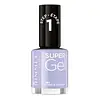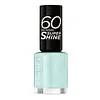What's inside
What's inside
 Key Ingredients
Key Ingredients

 Benefits
Benefits

 Concerns
Concerns

 Ingredients Side-by-side
Ingredients Side-by-side

Butyl Acetate
MaskingEthyl Acetate
PerfumingNitrocellulose
Acetyl Tributyl Citrate
MaskingIsopropyl Alcohol
SolventTosylamide/Epoxy Resin
Styrene/Acrylates Copolymer
Stearalkonium Bentonite
Gel FormingTriphenyl Phosphate
Glycidyl Neodecanoate/Phthalic Anhydride/Tmp Crosspolymer
Adipic Acid/Neopentyl Glycol/Trimellitic Anhydride Copolymer
Water
Skin ConditioningIsosorbide Dicaprylate/Caprate
Silica
AbrasiveDiacetone Alcohol
MaskingEtocrylene
UV AbsorberKaolin
AbrasiveHydroxyethyl Acrylate/Ipdi/PPG-15 Glyceryl Ether Copolymer
Acrylates/Dimethicone Copolymer
Skin ConditioningPhosphoric Acid
BufferingLithothamnion Calcareum Extract
Skin ConditioningCetyl PEG/PPG-10/1 Dimethicone
EmulsifyingN-Butyl Alcohol
PerfumingMannitol
HumectantDimethicone
EmollientTrimethylsiloxysilicate
EmollientTocopheryl Acetate
AntioxidantPolyvinyl Butyral
Solum Diatomeae
AbrasiveBenzophenone-1
UV AbsorberCorallina Officinalis Extract
Skin ConditioningTrimethylpentanediyl Dibenzoate
Polyethylene
AbrasiveCarthamus Tinctorius Seed Oil
MaskingButylene Glycol
HumectantZinc Sulfate
AntimicrobialMacrocystis Pyrifera Extract
Skin ConditioningHydrolyzed Conchiolin Protein
Skin ConditioningMethylparaben
PreservativeCI 77891
Cosmetic ColorantCI 15850
Cosmetic ColorantCI 19140
Cosmetic ColorantCI 77742
Cosmetic ColorantBlue 1 Lake
Cosmetic ColorantButyl Acetate, Ethyl Acetate, Nitrocellulose, Acetyl Tributyl Citrate, Isopropyl Alcohol, Tosylamide/Epoxy Resin, Styrene/Acrylates Copolymer, Stearalkonium Bentonite, Triphenyl Phosphate, Glycidyl Neodecanoate/Phthalic Anhydride/Tmp Crosspolymer, Adipic Acid/Neopentyl Glycol/Trimellitic Anhydride Copolymer, Water, Isosorbide Dicaprylate/Caprate, Silica, Diacetone Alcohol, Etocrylene, Kaolin, Hydroxyethyl Acrylate/Ipdi/PPG-15 Glyceryl Ether Copolymer, Acrylates/Dimethicone Copolymer, Phosphoric Acid, Lithothamnion Calcareum Extract, Cetyl PEG/PPG-10/1 Dimethicone, N-Butyl Alcohol, Mannitol, Dimethicone, Trimethylsiloxysilicate, Tocopheryl Acetate, Polyvinyl Butyral, Solum Diatomeae, Benzophenone-1, Corallina Officinalis Extract, Trimethylpentanediyl Dibenzoate, Polyethylene, Carthamus Tinctorius Seed Oil, Butylene Glycol, Zinc Sulfate, Macrocystis Pyrifera Extract, Hydrolyzed Conchiolin Protein, Methylparaben, CI 77891, CI 15850, CI 19140, CI 77742, Blue 1 Lake
Butyl Acetate
MaskingEthyl Acetate
PerfumingNitrocellulose
Acetyl Tributyl Citrate
MaskingIsopropyl Alcohol
SolventTosylamide/Epoxy Resin
Styrene/Acrylates Copolymer
Stearalkonium Bentonite
Gel FormingSilica
AbrasiveTriphenyl Phosphate
Adipic Acid/Neopentyl Glycol/Trimellitic Anhydride Copolymer
Water
Skin ConditioningDiacetone Alcohol
MaskingEtocrylene
UV AbsorberKaolin
AbrasiveGlycidyl Neodecanoate/Phthalic Anhydride/Tmp Crosspolymer
Mek
PerfumingSynthetic Fluorphlogopite
Corallina Officinalis Extract
Skin ConditioningAcrylates/Dimethicone Copolymer
Skin ConditioningIsosorbide Dicaprylate/Caprate
Dimethyl Isosorbide
SolventPhosphoric Acid
BufferingTrimethylsiloxysilicate
EmollientN-Butyl Alcohol
PerfumingDimethicone
EmollientTocopheryl Acetate
AntioxidantBenzophenone-1
UV AbsorberCetyl PEG/PPG-10/1 Dimethicone
EmulsifyingPolyvinyl Butyral
Polybutylene Glycol/Mdi Copolymer
Acetone
SolventTrimethylpentanediyl Dibenzoate
Polyethylene
AbrasiveStearalkonium Hectorite
Gel FormingHydrolyzed Conchiolin Protein
Skin ConditioningCarthamus Tinctorius Seed Oil
MaskingMacrocystis Pyrifera Extract
Skin ConditioningTin Oxide
AbrasiveMica
Cosmetic ColorantCI 47000
Cosmetic ColorantCI 77891
Cosmetic ColorantIron Oxides
CI 15850
Cosmetic ColorantCI 19140
Cosmetic ColorantCI 77742
Cosmetic ColorantCI 77007
Cosmetic ColorantCI 77000
Cosmetic ColorantCI 42090
Cosmetic ColorantCI 15880
Cosmetic ColorantCI 77510
Cosmetic ColorantCI 77163
Cosmetic ColorantCI 60725
Cosmetic ColorantButyl Acetate, Ethyl Acetate, Nitrocellulose, Acetyl Tributyl Citrate, Isopropyl Alcohol, Tosylamide/Epoxy Resin, Styrene/Acrylates Copolymer, Stearalkonium Bentonite, Silica, Triphenyl Phosphate, Adipic Acid/Neopentyl Glycol/Trimellitic Anhydride Copolymer, Water, Diacetone Alcohol, Etocrylene, Kaolin, Glycidyl Neodecanoate/Phthalic Anhydride/Tmp Crosspolymer, Mek, Synthetic Fluorphlogopite, Corallina Officinalis Extract, Acrylates/Dimethicone Copolymer, Isosorbide Dicaprylate/Caprate, Dimethyl Isosorbide, Phosphoric Acid, Trimethylsiloxysilicate, N-Butyl Alcohol, Dimethicone, Tocopheryl Acetate, Benzophenone-1, Cetyl PEG/PPG-10/1 Dimethicone, Polyvinyl Butyral, Polybutylene Glycol/Mdi Copolymer, Acetone, Trimethylpentanediyl Dibenzoate, Polyethylene, Stearalkonium Hectorite, Hydrolyzed Conchiolin Protein, Carthamus Tinctorius Seed Oil, Macrocystis Pyrifera Extract, Tin Oxide, Mica, CI 47000, CI 77891, Iron Oxides, CI 15850, CI 19140, CI 77742, CI 77007, CI 77000, CI 42090, CI 15880, CI 77510, CI 77163, CI 60725
Ingredients Explained
These ingredients are found in both products.
Ingredients higher up in an ingredient list are typically present in a larger amount.
Acetyl Tributyl Citrate is a fragrance.
This polymer has film-forming properties and helps leave behind a soft film on the skin with oxygen permeability.
That's why you'll most likely find this in sunscreen formulations.
We don't have a description for Adipic Acid/Neopentyl Glycol/Trimellitic Anhydride Copolymer yet.
Benzophenone-1 absorbs UV.
We don't have a description for Butyl Acetate yet.
Carthamus tinctorius seed oil comes from safflower, one of humanity's oldest crops.
Safflower seed oil contains a high percentage of linoleic acid and oleic acid. It also contains Vitamin E. These three components are effective moisturizers.
Vitamin E helps nourish your skin's lipid barrier. It is also a potent antioxidant. Antioxidants help fight free-radical molecules, or unstable molecules that may damage your skin cells.
Due to its high fatty acid content, this ingredient may not be malassezia folliculitis safe.
Thoughout history, safflower has been used for dying fabrics and in food as a saffron substitute.
Learn more about Carthamus Tinctorius Seed OilThis ingredient is a high molecular weight silicone. It has emulsifying and skin conditioning properties.
Ci 15850 is the pigment color red. It is an azo dye and created synthetically.
Azo dyes need to be thoroughly purified before use. This allows them to be more stable and longer-lasting.
This ingredient is common in foundations, lipsticks, and blushes. This color is described as brown/orangey red.
It has many secondary names such as Red 6 and Red 7. According to a manufacturer, Red 6 usually contains aluminum.
Learn more about CI 15850CI 19140 is also known as Tartrazine. Tartrazine is a synthetic dye used in cosmetics, foods, and medicine to add a yellow color.
Tartrazine is created from petroleum and is water-soluble.
Some people may experience allergies from this dye, especially asthmatics and those with an aspirin intolerance.
Learn more about CI 19140This ingredient is used to add a violet color to cosmetics.
It is created by reacting phosphoric acid, ammonium dihydrogen orthophosphate, and manganese dioxide.
Ci 77891 is a white pigment from Titanium dioxide. It is naturally found in minerals such as rutile and ilmenite.
It's main function is to add a white color to cosmetics. It can also be mixed with other colors to create different shades.
Ci 77891 is commonly found in sunscreens due to its ability to block UV rays.
Learn more about CI 77891Corallina Officinalis Extract is from the red seaweed, Corallina Officinalis. This seaweed is found all over the world but is most common in the rocky shores of Great Britain and Ireland.
Corallina Officinalis Extract contains antioxidant and emollient properties.
Extracted polysaccharides, galactose and xylose, in red algae showed antioxidant activity. Antioxidants help with anti-aging by neutralizing free-radical molecules. Free-radical molecules may damage your skin cells and DNA. Galactose is also a PHA.
Corallina Officinalis is structurally similar to coral due to its high calcium content.
Learn more about Corallina Officinalis ExtractWe don't have a description for Diacetone Alcohol yet.
Dimethicone is a type of synthetic silicone created from natural materials such as quartz.
What it does:
Dimethicone comes in different viscosities:
Depending on the viscosity, dimethicone has different properties.
Ingredients lists don't always show which type is used, so we recommend reaching out to the brand if you have questions about the viscosity.
This ingredient is unlikely to cause irritation because it does not get absorbed into skin. However, people with silicone allergies should be careful about using this ingredient.
Note: Dimethicone may contribute to pilling. This is because it is not oil or water soluble, so pilling may occur when layered with products. When mixed with heavy oils in a formula, the outcome is also quite greasy.
Learn more about DimethiconeEthyl Acetate is a fragrance.
We don't have a description for Etocrylene yet.
We don't have a description for Glycidyl Neodecanoate/Phthalic Anhydride/Tmp Crosspolymer yet.
We don't have a description for Hydrolyzed Conchiolin Protein yet.
Isopropyl Alcohol is more commonly known as rubbing alcohol. It is most commonly used as a solvent, meaning it helps other ingredients dissolve.
This ingredient is an astringent alcohol. Astringent alcohols may also irritate skin as they high amounts may strip away your skin's natural oils.
Other types of astringent alcohols include:
According to the National Rosacea Society based in the US, you should be mindful of products with these alcohols in the top half of ingredients.
Any type of sanitizing product will have high amounts of alcohol to help kill bacteria and viruses.
Learn more about Isopropyl AlcoholWe don't have a description for Isosorbide Dicaprylate/Caprate yet.
Kaolin is a clay. It is used for oil control and to help minimize pores. Like other clays, kaolin has the ability to absorb excess sebum or oil. This can help clean out pores and mattify the skin.
Some types of kaolin may have exfoliating properties. When water is added to kaolin, it becomes a paste with small abrasive particles.
Most kaolin is a white color, but may be pink/orange/red depending on where it comes from.
The name 'kaolin' comes from a Chinese village named 'Gaoling'. Kaolin clay comes from rocks rich in kaolinite. Kaolinite, the mineral, has a silicate layered structure. Kaolinite is formed from chemical weathering of aluminum siilicate minerals.
Besides skincare, kaolin is commonly used to make glossy paper, in ceramics, toothpaste, and as medicine to soothe stomach issues.
Learn more about KaolinThis ingredient comes from a brown kelp called Macrocystis pyrifera. It is rich in antioxidants and can help hydrate skin.
Brown kelp are rich in unsaturated fatty acids and phlorotannins. Phlorotannins have been found to help with inhibiting melanin production and helping reduce the signs of aging due to their high antioxidant activity.
One study suggests phlorotannins may even have some sun protection factor due to their antioxidant activity. However, this ingredient should not replace your sunscreen.
Macrocystis pyrifera is made up of about: 60% carbohydrates, 10% protein, and 1.50% lipid content. The last 30% is kelp ash.
This kelp can be found in the southern hemisphere and north Pacific.
Learn more about Macrocystis Pyrifera ExtractN-Butyl Alcohol is a fragrance.
We don't have a description for Nitrocellulose yet.
Phosphoric acid is used to adjust the pH of products.
Polyethylene is a synthetic ingredient that helps the skin retain moisture. It is a polymer.
It is also typically used within product formulations to help bind solid ingredients together and thicken oil-based ingredients. When added to balms and emulsions, it helps increase the melting point temperature.
We don't have a description for Polyvinyl Butyral yet.
Silica, also known as silicon dioxide, is a naturally occurring mineral. It is used as a fine, spherical, and porous powder in cosmetics.
Though it has exfoliant properties, the function of silica varies depending on the product.
The unique structure of silica enhances the spreadability and adds smoothness, making it a great texture enhancer.
It is also used as an active carrier, emulsifier, and mattifier due to its ability to absorb excess oil.
In some products, tiny microneedles called spicules are made from silica or hydrolyzed sponge. When you rub them in, they lightly polish away dead skin layers and enhance the penetration of active ingredients.
Learn more about SilicaWe don't have a description for Stearalkonium Bentonite yet.
We don't have a description for Styrene/Acrylates Copolymer yet.
Tocopheryl Acetate is AKA Vitamin E. It is an antioxidant and protects your skin from free radicals. Free radicals damage the skin by breaking down collagen.
One study found using Tocopheryl Acetate with Vitamin C decreased the number of sunburned cells.
Tocopheryl Acetate is commonly found in both skincare and dietary supplements.
Learn more about Tocopheryl AcetateWe don't have a description for Tosylamide/Epoxy Resin yet.
We don't have a description for Trimethylpentanediyl Dibenzoate yet.
This silicone is an emollient. Emollients create a thin film on the skin to prevent moisture from escaping.
It is not soluble in water and helps increase water-resistance in products.
According to a manufacturer, it can blend seamlessly with silicone oils, such as Cyclopentasiloxane.
Learn more about TrimethylsiloxysilicateWe don't have a description for Triphenyl Phosphate yet.
Water. It's the most common cosmetic ingredient of all. You'll usually see it at the top of ingredient lists, meaning that it makes up the largest part of the product.
So why is it so popular? Water most often acts as a solvent - this means that it helps dissolve other ingredients into the formulation.
You'll also recognize water as that liquid we all need to stay alive. If you see this, drink a glass of water. Stay hydrated!
Learn more about Water